Undergrad Student research predicts stock market valuations
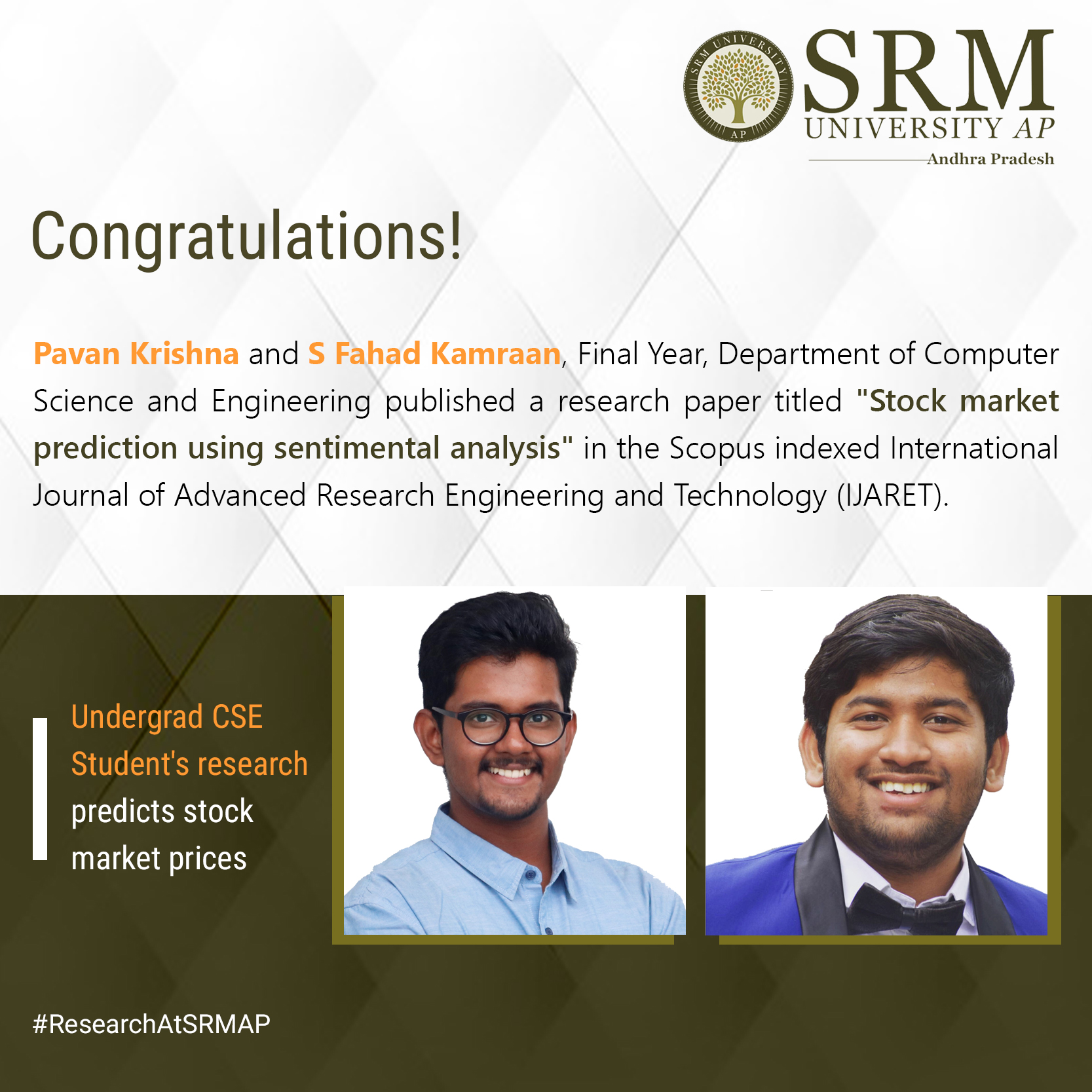 Pavan Krishna and S Fahad Kamraan, guided by Dr Priyanka, Department of Computer Science and Engineering, SRM University-AP, Andhra Pradesh, successfully published a research paper titled “Stock market prediction using sentimental analysis” in the Scopus indexed “International Journal of Advanced Research Engineering and Technology (IJARET)” on March 2021. Being the students of the Department of Computer Science and Engineering, both researchers have apt knowledge on the sentimental analysis commonly known as opinion mining or emotion AI led to the successful execution of the research project.
Pavan Krishna and S Fahad Kamraan, guided by Dr Priyanka, Department of Computer Science and Engineering, SRM University-AP, Andhra Pradesh, successfully published a research paper titled “Stock market prediction using sentimental analysis” in the Scopus indexed “International Journal of Advanced Research Engineering and Technology (IJARET)” on March 2021. Being the students of the Department of Computer Science and Engineering, both researchers have apt knowledge on the sentimental analysis commonly known as opinion mining or emotion AI led to the successful execution of the research project.
Sentimental analysis is used to help find patterns in textual data, to understand people’s emotions and sentiments in a much deeper and holistic way. It is used to find the polarity of the information and to classify it under different emotion/ sentiment radar all the way from sad to happy or too excited.
The key title takes a dig into a study involving a new method of predicting stocks by performing sentimental analysis on the financial data. A sentiment is analysed on the subjectivity and polarity index by classifying it into positive and negative news. Here, to predict the real-time stock price, sentiment analysis measures the polarity or subjectivity score, respectively.
“While pursuing my minor in Business Management, I gained Financial Literacy and eventually found an interest in the Stock Market & its behaviour. At the same time, we noticed how social media plays a crucial role in deciding stock prices. Fahad and I were so intrigued that we decided to take up a Project on Predicting Stock Market Prices based on Sentimental Analysis of statement – News & Tweets”, informed Pavan.
Fahad further acknowledged that the project was a big step for undergraduate students, and it could not have been possible without the guidance and motivation of Dr Priyanka, their mentor. “Dr Priyanka was the constant support and path-bearer for us as she showed immense faith until the goal is achieved”, said Fahad.
The duo was excited after receiving high praises and acclaims for their research project. They look forward to coming up with more research ideas that can benefit society.
- Published in CSE NEWS, Departmental News, News, Research News, Students Achievements
SRM University-AP Student earns Erasmus Mundus Scholarship 2021
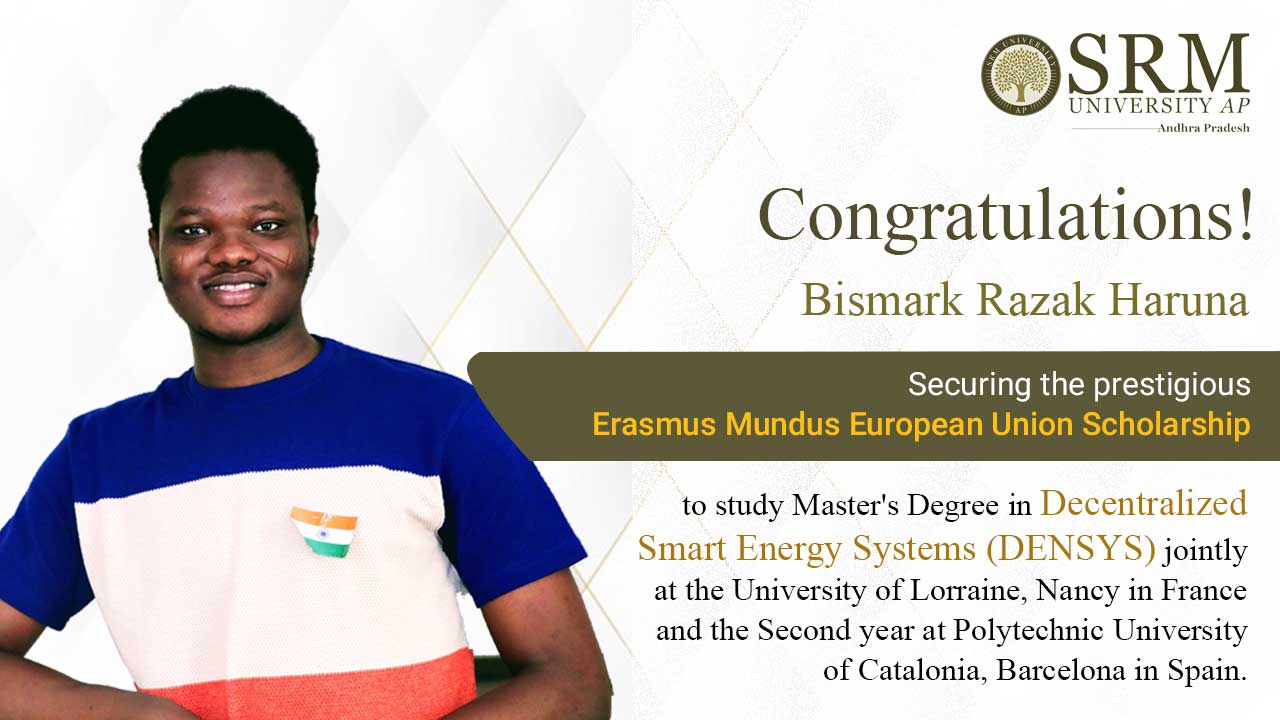 Since its inception, SRM University-AP, Andhra Pradesh, has retained its exalted heights of excellence and brilliance. Avid students over the years have brought laurels to the organisation with impressive research work, outstanding academic performance or Guinness World Record for spectacular artistry. Bismark Razak Haruna, a B. Tech Final Year Student at the Department of Mechanical Engineering, is deemed to be bestowed on the highly prestigious Erasmus Mundus scholarship. The globally acclaimed European Union-funded scholarship will help Bismark pursue the joint master’s degree programme in Decentralised Smart Energy Systems (DENSYS) in renowned universities of Europe.
Since its inception, SRM University-AP, Andhra Pradesh, has retained its exalted heights of excellence and brilliance. Avid students over the years have brought laurels to the organisation with impressive research work, outstanding academic performance or Guinness World Record for spectacular artistry. Bismark Razak Haruna, a B. Tech Final Year Student at the Department of Mechanical Engineering, is deemed to be bestowed on the highly prestigious Erasmus Mundus scholarship. The globally acclaimed European Union-funded scholarship will help Bismark pursue the joint master’s degree programme in Decentralised Smart Energy Systems (DENSYS) in renowned universities of Europe.
Bismark sets an example by being the first Ghanaian to get into the DENSYS program. He expressed that as part of the mobility scheme of the programme, he would pursue the first year at the University of Lorraine, Nancy, France, and continue the final year at the Polytechnic University of Catalonia, Barcelona, Spain. The Erasmus Mundus Scholarship help students enrol into the world’s best universities for masters and doctoral programmes with substantial benefits. Bismark shared his thoughts, “I welcome the opportunity to play an important role in increased electrification in Sub-Saharan Africa through the integration of renewable energy sources for a low carbon society”.
Approximately 392 aspirants applied for the DENSYS program globally, and out of 23 students from 17 countries, Bismark secured his place. Erasmus Mundus Scholarship Programme covers the expenditure involving the tuition fee, insurance, participation in activities such as the lab courses, excursion, research projects, financial support for housing, feeding, transportation and installation fee as well.
While speaking of his success, Bismark expressed his gratitude towards the SRM University-AP for consistently providing him with golden opportunities and resources. “From conceptualising undergraduate research project to studying abroad at UC Berkeley, the University has been a constant support. A special thanks to my motivators and mentors- Dr Prakash Jadav, Dr Satya Pramod Jammy, Dr Sarfaraz Hussain Halkarni, Dr Ram Kuresh Thakur, Dr Srabani Basu, Ms Revathi Balakrishnan for grooming and guiding me throughout the journey. I convey my sincere thanks to my buddies as well for helping me out with the scholarship application”, Bismark added while being ready for exploring the next chapter of his life in the European Union.
- Published in Departmental News, Mechanical Engineering NEWS, News, Students Achievements
Prediction of End-Time of COVID-19 Spread in AP
In the current pandemic situation, a pertinent question is an estimate of the time by which virus spread could be contained and normalcy would return. In this context,Prof.Narayana Rao, Pro Vice Chancellor, SRM University – AP initiated the study. Dr. Soumyajyoti Biswas of SRM University AP, along with 4 B.Tech Students have carried out an interesting study to predict the end time of COVID-19 spread in the state of Andhra Pradesh. The study employed Susceptible – Infected – Recovered (SIR) Model, making use of the information on the COVID-19 affected people and the recovered number of people, which the Government of AP makes it available through the control command center. SRM Team made use of this data, employed SIR Model and applied the methods of Machine Learning. Study reveals that by July 15th 2021, the rate of infection in AP will be below 100 per day.
With the assumption that the decay rate of infection is same as the growth rate, the model predicts that the number of infected people could be 10,000 (May 21), 15,000 (May 30), 1000 (June 14), 500 (June 23) and 100 (July 15)
The above report has been submitted to the Special Chief Secretary to the Hon’ble Chief Minister of Andhra Pradesh.
Media Panorama
- Published in News, Physics News, Research News
SRM University-AP & Titan Company Ltd collaborate to engineer novel gold alloys for contemporary jewellery
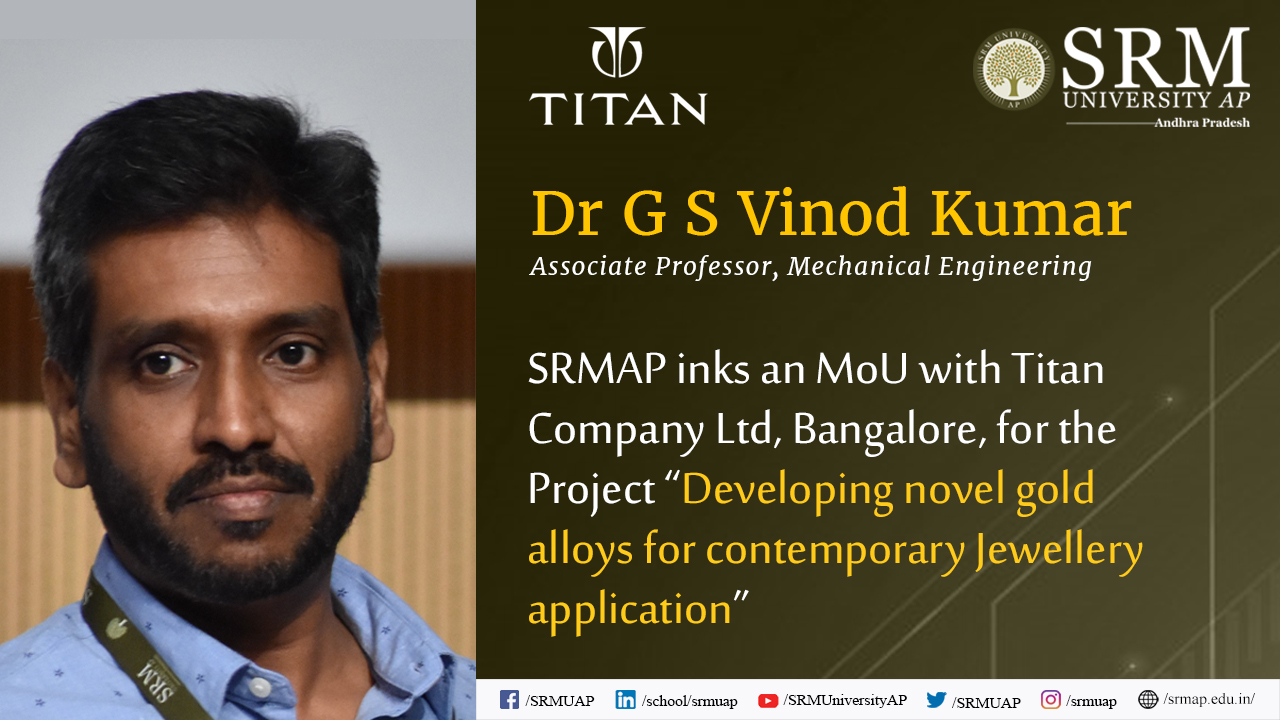 SRM University-AP inked an MOU with Titan Company Ltd (TATA group,) Bangalore, for the project “Developing novel gold alloys for contemporary Jewellery application”. Titan has sanctioned Rs. 29.6 lakhs for the execution of the project to Dr G S Vinod Kumar, Associate Professor in the Department of Mechanical Engineering and Principal Investigator of the project. Dr Vinod is well known for his research in precious metals such as gold and silver for making lightweight and high strength alloys that can be used in jewellery making.
SRM University-AP inked an MOU with Titan Company Ltd (TATA group,) Bangalore, for the project “Developing novel gold alloys for contemporary Jewellery application”. Titan has sanctioned Rs. 29.6 lakhs for the execution of the project to Dr G S Vinod Kumar, Associate Professor in the Department of Mechanical Engineering and Principal Investigator of the project. Dr Vinod is well known for his research in precious metals such as gold and silver for making lightweight and high strength alloys that can be used in jewellery making.
The jewellery division of Titan Company Ltd (TANISHQ) will jointly work on this project by supplying Gold for lab-scale experiments. The Industrial scaling up trials of the technology will be carried out at Titan’s jewellery manufacturing plant at Hosur, Tamil Nadu.
This is the fourth project sanctioned by Titan Company Ltd to Dr G S Vinod Kumar and the second project in Gold. The first project “Hardening of 22Karat and 24Karat gold for lightweight and high strength jewellery application” was successfully completed in 2018 by Dr Vinod and his team. A joint patent between SRM and Titan Company Ltd has been filed and the jewellery produced from hard 22Karat gold is currently available in Titan showrooms under the brand-TANISHQ.
- Published in Mechanical Engineering NEWS, News, Research News
Novel designs for electrochemical ammonia synthesis to substitute Haber-Bosch process
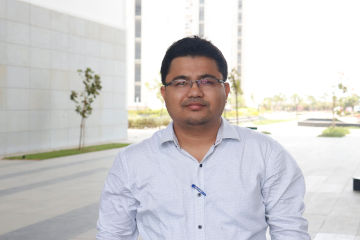 Professor Ranjit Thapa, Head of the Department of Physics, has recently published a paper “Unveiling the Genesis of the High Catalytic Activity in Nickel Phthalocyanine for Electrochemical Ammonia Synthesis” in the renowned Journal of Materials Chemistry A, Royal Society of Chemistry (Impact Factor: 11.301). The work has been done in collaboration with the Department of Industrial Chemistry & Applied Chemistry, Swami Vivekananda Research Centre, Ramakrishna Mission Vidyamandira, Belur Math, Howrah; Rubber Technology Centre, Indian Institute of Technology, Kharagpur; and Atomic & Molecular Physics Division, Bhabha Atomic Research Centre, Mumbai, India.
Professor Ranjit Thapa, Head of the Department of Physics, has recently published a paper “Unveiling the Genesis of the High Catalytic Activity in Nickel Phthalocyanine for Electrochemical Ammonia Synthesis” in the renowned Journal of Materials Chemistry A, Royal Society of Chemistry (Impact Factor: 11.301). The work has been done in collaboration with the Department of Industrial Chemistry & Applied Chemistry, Swami Vivekananda Research Centre, Ramakrishna Mission Vidyamandira, Belur Math, Howrah; Rubber Technology Centre, Indian Institute of Technology, Kharagpur; and Atomic & Molecular Physics Division, Bhabha Atomic Research Centre, Mumbai, India.
The slow kinetics of N2 adsorption, splitting of the strong N≡N bond are the challenges for the electrocatalytic nitrogen reduction reaction (NRR) process. In the electrocatalytic NRR process, the fast reaction kinetics of hydrogen evolution reaction is the greatest obstacle. To solve these challenges, the search for various types of catalysts is on a roll. Also, identifying active sites responsible for the origin of catalytic activity in transition metal phthalocyanine is difficult due to its complex structure. Herein, density functional theory (DFT) has been applied to identify the probable active sites of nickel phthalocyanine (NiPc) in NRR as well as the origin of catalytic activity, which is associated with d band centre and density of states (DOS) of Ni in NiPc. Accordingly, the NiPc nanorods (NRs) were synthesised by the solvothermal method on a large scale and the chemically prepared NiPc NRs exhibit the NH3 yield rate of about 85 μg h-1mgcat-1.
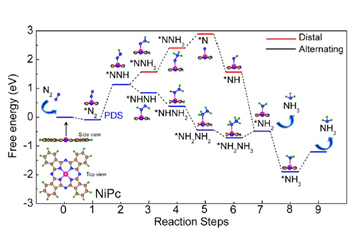 In 2019, the global production capacity of ammonia was 235 million metric tons which will increase to 290 million metric tons by 2030. This emphasis on ammonia is due to its application in broad and diverse fields, such as fertilisers, textiles, pharmaceutical, and carbon-free energy carriers. The Haber-Bosch process is used to synthesise ammonia (NH3) from N2 and H2 using Fe based catalyst. However, the process emits carbon dioxide (CO2) (1.5 tons of CO2/tons of NH3 production) and requires high pressure and temperature and consumes around 2% of the global energy supply. Electrocatalytic N2 fixation (N2 + 6H+ + 6e− → 2NH3) showed great potential due to the possible use of atmospheric nitrogen and hydrogen derived from water through electrolysis and in mild conditions.
In 2019, the global production capacity of ammonia was 235 million metric tons which will increase to 290 million metric tons by 2030. This emphasis on ammonia is due to its application in broad and diverse fields, such as fertilisers, textiles, pharmaceutical, and carbon-free energy carriers. The Haber-Bosch process is used to synthesise ammonia (NH3) from N2 and H2 using Fe based catalyst. However, the process emits carbon dioxide (CO2) (1.5 tons of CO2/tons of NH3 production) and requires high pressure and temperature and consumes around 2% of the global energy supply. Electrocatalytic N2 fixation (N2 + 6H+ + 6e− → 2NH3) showed great potential due to the possible use of atmospheric nitrogen and hydrogen derived from water through electrolysis and in mild conditions.
In their future endeavours, Prof Thapa and his research group will design different types of such single-atom catalyst (SAC) considering different metal atoms and their surrounding non-metals. Dr Thapa’s team necessitates addressing the above problem to fill the gap, which could be the energy equation, energy parameter and electronic descriptor, to help them predict the best SAC catalyst in the large catalyst space for eNRR over HER. The solution is much needed through density functional theory to understand the origin and design principle and lower the time for trials by experimentalists in the laboratory. Prof Thapa is working on energy equations that can predict the best catalyst for eNRR over HER. They defined four regions to find the SAC catalyst for eNRR over HER (1) catalyst for NRR with almost nil HER probability (ii) catalyst for NRR with low HER probability (iii) HER over NRR and (iv) NRR is possible but with H poisoning. Overall, the energy parameter and descriptor to find NRR over HER is a fundamental problem, and the database is a platform to be used by experimentalists and is the key idea.
Read the full paper: https://doi.org/10.1039/D1TA00766A.
- Published in News, Physics News, Research News
Dr Satya Pramod Jammy receives a grant to research missiles and space vehicles
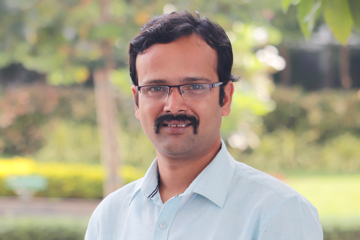 Dr Satya Pramod Jammy, Associate Professor, Department of Mechanical Engineering, SRM University-AP, Andhra Pradesh, has received a total outlay of Rs. 38,61, 264/- from Department of Science and Technology (DST) Science and Engineering Research Board, Government of India, to work on the project titled “Wall effects in Shock wave boundary layer interactions”. Using the grant, state-of-the-art HPC computational facilities based on the exciting General Purpose Graphic Processing Units (GPGPU’s) will be set up to perform missiles and space vehicle research at SRM University AP. Understanding the fundamental physics of how these vehicles behave in challenging atmospheres will contribute a lot to the design of current and future space vehicles re-entering from space into earth and mars atmospheres. The project aims to develop methods that can capture high-resolution images (like a DSLR camera) of these flows using minimal computational resources.
Dr Satya Pramod Jammy, Associate Professor, Department of Mechanical Engineering, SRM University-AP, Andhra Pradesh, has received a total outlay of Rs. 38,61, 264/- from Department of Science and Technology (DST) Science and Engineering Research Board, Government of India, to work on the project titled “Wall effects in Shock wave boundary layer interactions”. Using the grant, state-of-the-art HPC computational facilities based on the exciting General Purpose Graphic Processing Units (GPGPU’s) will be set up to perform missiles and space vehicle research at SRM University AP. Understanding the fundamental physics of how these vehicles behave in challenging atmospheres will contribute a lot to the design of current and future space vehicles re-entering from space into earth and mars atmospheres. The project aims to develop methods that can capture high-resolution images (like a DSLR camera) of these flows using minimal computational resources.
Dr Jammy is an expert in multi-scale modelling of turbulent flows at high Mach numbers. He is also the lead developer of OpenSBLI, a free and open-source software (FOSS) distributed to the community for free. Dr Jammy and his group will focus on unravelling the concepts like engine unstart in SCRAMJETS, design of better aerodynamic control surfaces for re-entry.
- Published in Mechanical Engineering NEWS, News, Research News
P Mohan Aditya granted copyright for biodegradable Face Shield design
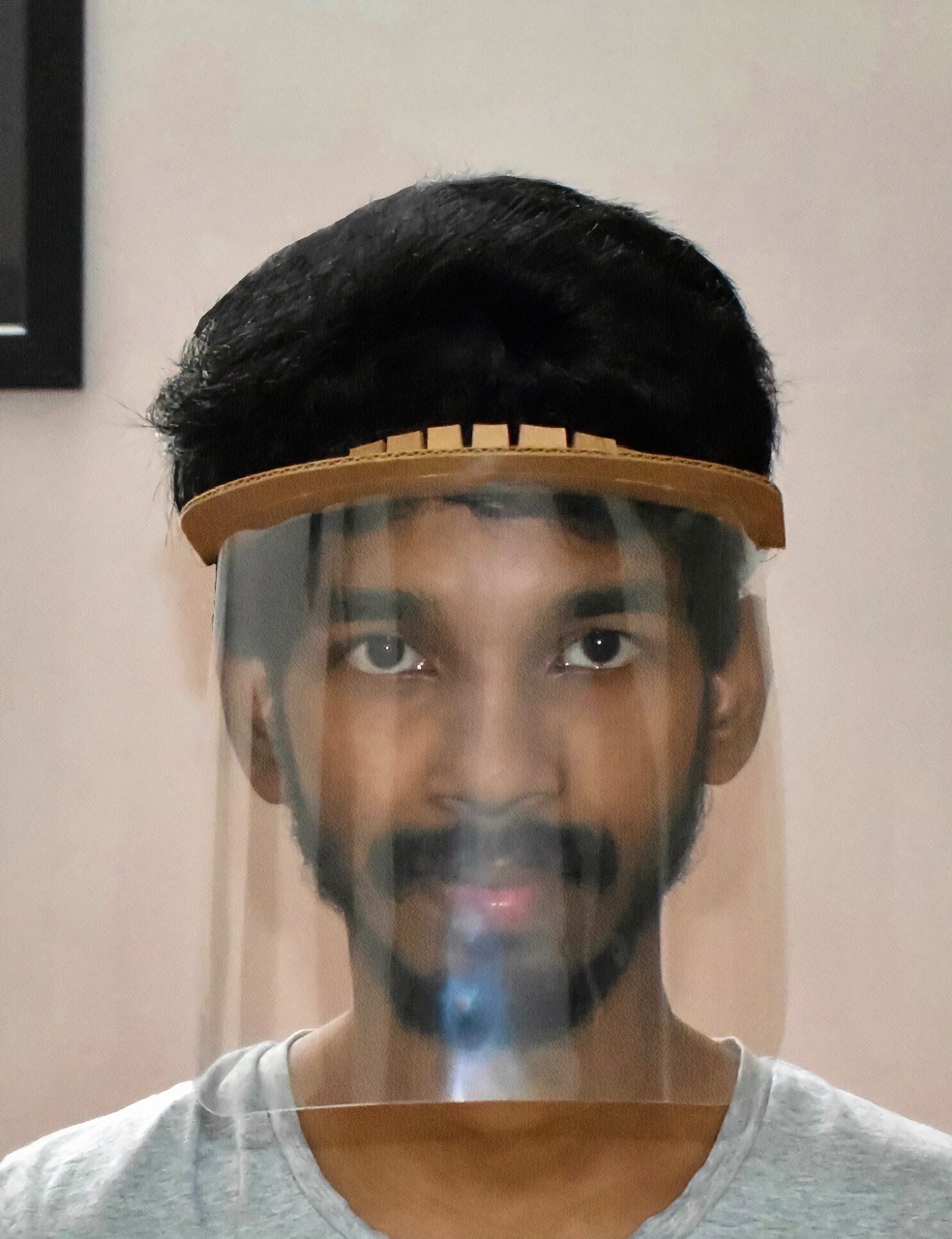 When the Covid-19 outbreak crippled the world, P Mohan Aditya, a 3rd-year Mechanical Engineering student from SRM University-AP, made an initiative of developing the highly useful face shield made from bio-degradable substances. He named it “Facial Shield 2.0”, as it was an improved version of the ordinary face shields. The innovative features added to it helped him to earn the copyright to his credit. On May 16, 2020, Aditya filed an application on the face shield design under the IPR (Intellectual Property Rights) with Indian Patent Office, located in Kolkata, India. In 2021, a copyright was granted for the” Face Shield for Humans” with a Design Application Number of 329364 – 001.
When the Covid-19 outbreak crippled the world, P Mohan Aditya, a 3rd-year Mechanical Engineering student from SRM University-AP, made an initiative of developing the highly useful face shield made from bio-degradable substances. He named it “Facial Shield 2.0”, as it was an improved version of the ordinary face shields. The innovative features added to it helped him to earn the copyright to his credit. On May 16, 2020, Aditya filed an application on the face shield design under the IPR (Intellectual Property Rights) with Indian Patent Office, located in Kolkata, India. In 2021, a copyright was granted for the” Face Shield for Humans” with a Design Application Number of 329364 – 001.
The face shield 2.0 serves as the outer defence to the mucous membranes (nose, eyes, and mouth) and comes with a transparent visor made of a thin layer of 175-micron reusable plastic and a highly durable headband made of 3-ply corrugated cardboard. The cardboard’s bursting strength is 16kg/sq.cm, which is quite durable yet lightweight. Due to the use of biodegradable materials, the price of a face shield is at an affordable cost of INR 15. The face shield 2.0, made with firm elastic, is adjustable and suitable for all head sizes for comfortable wear without hurting the head.
Shri Adimulapu Suresh, Hon’ble Minister of Education, Andhra Pradesh and Sri Nandigama Suresh, Hon’ble MP, appreciated the student’s efforts in the Secretariat’s premises. Aditya received high accolades from the guests present on his first successful invention. They also distributed face shields among state police officers, paramedics and other frontline workers deployed in the containment areas.
In a conversation with P Mohan Aditya, he says, “With an increasing environmental degradation, we should move to the eco-friendly alternatives to develop products/services. Therefore, I thought to develop face shields from reusable plastic and cardboard, which are easily degradable. After discovering a shortage in the supply of Personal Protective Equipment (PPE) globally, the idea struck my mind. Immediately I started researching on developing a piece of standard equipment to combat the Covid-19 pandemic. I am thankful to Mr Ravi, the attorney at SRM-AP, who supported me throughout the tough times by answering all doubts amidst challenging circumstances.”
 Aditya’s invention turned out to be a successful project both for the University and the public. The leadership team of SRM University-AP – Dr P Sathyanarayanan, President, Prof V S Rao, Vice-Chancellor, and Prof D Narayana Rao, Pro-Vice-Chancellor expressed their happiness on Aditya’s success by congratulating him on developing the face shield and making use of eco-friendly technology.
Aditya’s invention turned out to be a successful project both for the University and the public. The leadership team of SRM University-AP – Dr P Sathyanarayanan, President, Prof V S Rao, Vice-Chancellor, and Prof D Narayana Rao, Pro-Vice-Chancellor expressed their happiness on Aditya’s success by congratulating him on developing the face shield and making use of eco-friendly technology.
Using the CAD software, Aditya designed the transparent visor of the face shield and fabricated the remaining headband with the CNC machine. The CAD model was used as the input to the CNC machine, Following the design, the CNC machine analysed and cut the cardboard and transparent sheet accordingly.
P Mohan Aditya’s another innovative design on “building block for bed” was applied for a copyright on 09-08-2020. The building block for bed is again an innovative work of making beds using reusable materials for COVID 19 patients. He and his team also successfully created an electric bicycle using a 24V 250Watt DC motor powered by a 12V and 12Ah battery as a team assignment. Aditya desires to be a successful engineer and creator of such inventions for the betterment of society.
- Published in Mechanical Engineering NEWS, News, Research News, Students Achievements
Grad students developed society friendly apps, won Hackathons
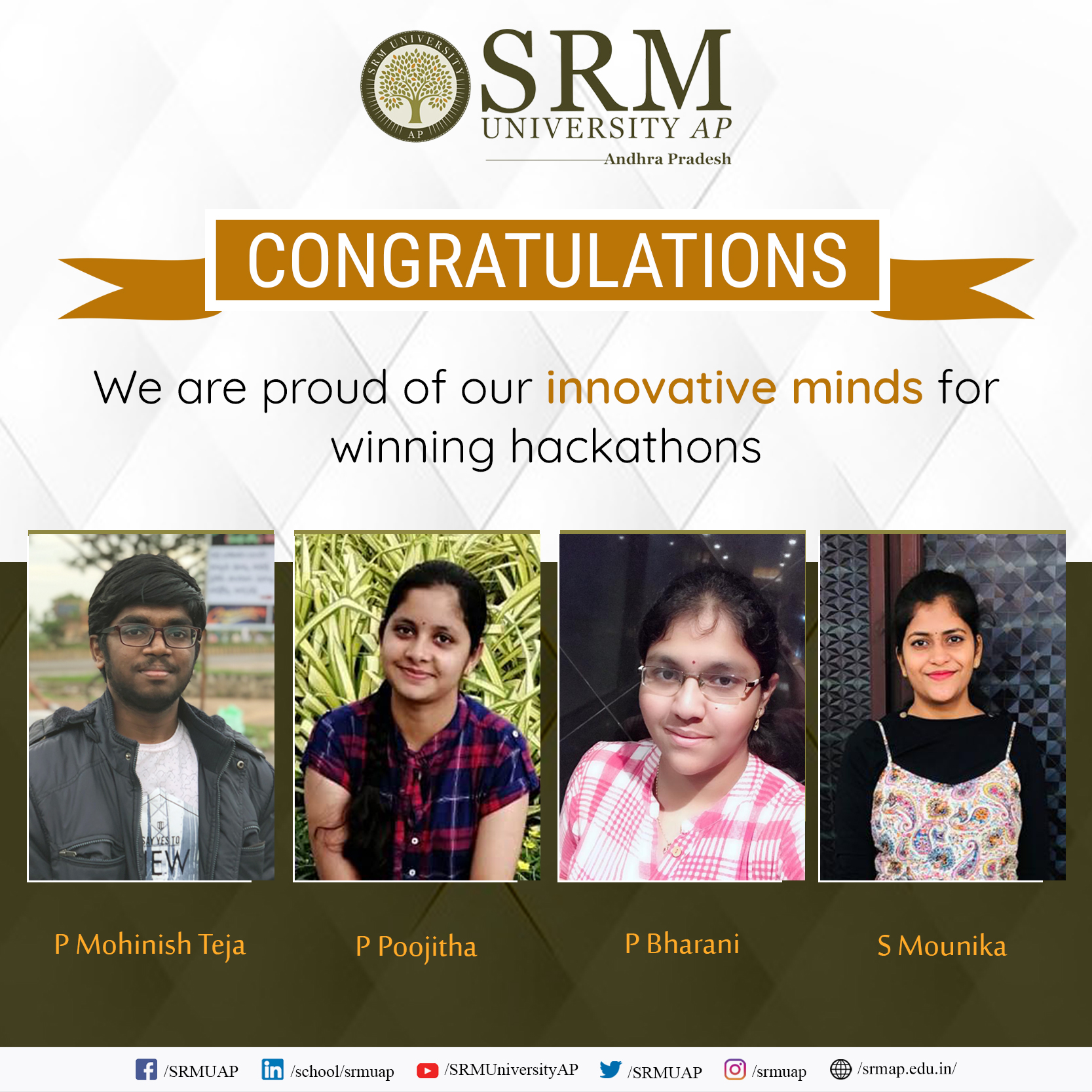 The SRM University-AP student, P Mohinish Teja from the Department of Computer Science and Engineering, brings laurel to the university by bagging the first prize at the Hackathon organised this year on April 16-18th by the Cal Hacks Team, University of California, Berkeley. More than 450 participants signed up for the world’s popular code-fest. Amongst these global participants, Mohinish won the title of “Best Hack” and a prize of $1000 worth of file coins from the sponsoring partner, Protocol Labs.
The SRM University-AP student, P Mohinish Teja from the Department of Computer Science and Engineering, brings laurel to the university by bagging the first prize at the Hackathon organised this year on April 16-18th by the Cal Hacks Team, University of California, Berkeley. More than 450 participants signed up for the world’s popular code-fest. Amongst these global participants, Mohinish won the title of “Best Hack” and a prize of $1000 worth of file coins from the sponsoring partner, Protocol Labs.
The idea of the application “Eco gift” is inspired by the Undergraduate Research Oriented Project under the guidance of Dr Ashok Kumar Pradhan, Assistant Professor-CSE and Mr Santosh Bhaskara, doctoral research scholar. Mohinish developed a Waste Management Decentralised Application called “Eco gift” using Blockchain Technology that rewards the users who categorically dump the waste. This application credits crypto tokens into the app users’ wallet. Even though it will not be the traditional currency, it can be used during registration, paying application fees, and payments at the government portals. The reward value increases with time, and the individual receives the token immediately after installing the application.
Mohinish led the team members P Poojitha, P Bharani, and S Mounika into another segment of Hackathon, Civhacks, organised by the Association of Students at the University of California, Berkeley, from April 23-25th where they bagged the “Best Civhacks” title.
The team developed a website application called “Anonymous Hawk” that displays the reported news by keeping the identity of the reporter anonymous for security reasons. The reporters facing life threats for reporting on the sensitive issue can sign up on the application. One can register simply by signing the transaction into the Blockchain. The data uploaded is stored in the Ethereum network and cannot be trifled by humans or software. The free flow of the information can take place by using the application without the fear of being targeted by any influential agents.
“Anonymous Hawk” brought each group member a prize of $500 file coins. The team was granted an opportunity to work further on the project by the sponsoring team, Protocol Labs. Mohinish expressed, “We are at the initial stage of the development of the high-end Decentralised App. In the next stage, we shall work on controlling the spamming of the information using the data and web-mining algorithms.”
- Published in CSE NEWS, News, Students Achievements
ECE Students admitted to prestigious universities across the globe
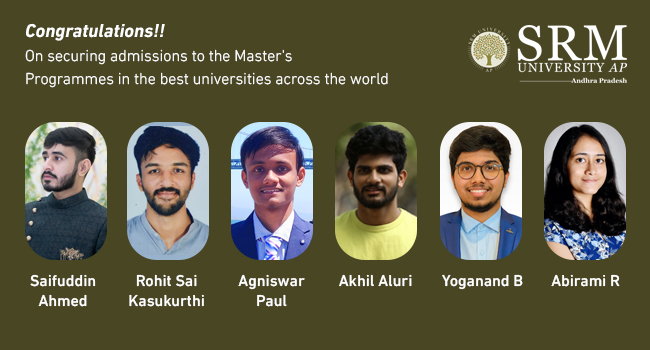 The Department of Electronics and Communication at SRM University-AP, Andhra Pradesh, is overjoyed to announce its students’ success in pursuing higher education. Six students from the maiden batch have performed brilliantly and been accepted to prestigious universities in the United States. These students are offered the opportunity to pursue a master’s degree in their chosen fields. Four of the six pupils have been accepted to New York University, and the remaining two are admitted to The University of Wisconsin-Madison and Georgia Institute of Technology in the United States of America.
The Department of Electronics and Communication at SRM University-AP, Andhra Pradesh, is overjoyed to announce its students’ success in pursuing higher education. Six students from the maiden batch have performed brilliantly and been accepted to prestigious universities in the United States. These students are offered the opportunity to pursue a master’s degree in their chosen fields. Four of the six pupils have been accepted to New York University, and the remaining two are admitted to The University of Wisconsin-Madison and Georgia Institute of Technology in the United States of America.
Saifuddin Ahmed, Akhil Aluri, Rohit Sai K, and Abirami Ravishankar have been awarded a handsome annual scholarship from New York University. The host university offered a grant of $10,000, $8000, $8000, and $11000, respectively. Among the four students, Saifuddin, Akhil, Rohit and Abirami, the first three opted for a master’s in Management of Technology and Abirami enrolled in the Department of Electrical Engineering. Agnishwar Paul is selected by Georgia Tech University while B Yogananda took admission in the Master’s-Research Programme at The University of Wisconsin-Madison. Yogananda has received an offer for Teaching Assistantship from University of Wisconsin, Madison and as a part of it, he will also be receiving a Monthly Stipend and full Tuition Fee Wavier.
Students indicated that the in-depth knowledge that they gained during their B. Tech studies made them very confident while applying for higher studies. Agniswar said, “The curriculum that is followed in the university is up-to-date and at par with reputed global universities. It helped me a lot to catch up with the expectations of my preferred university.” Saifuddin added, “I was a bit doubtful at first whether to pursue higher studies after graduation. But the sincere guidance of Dr Sunil Chinnadurai and Higher Connect Club invoked the hunger in me to seek more knowledge.”
Higher Connect Club (HCC) is the university’s dedicated wing to connect all ECE students interested in pursuing Higher Education after they graduate from SRM University – AP. This club is focused on clarifying all the doubts that usually arise in a student’s mind when pursuing higher education and provides required support with all the resources required, guiding in the best possible way.
“My professors helped me to come up with the right strategy to score well in GRE. All of our teachers have international exposures. It helped a lot during our preparations for higher studies,” said Yogananda. Apart from strong grades in undergraduate courses, selection rounds of interviews needed proficiency in work experience and extracurricular activities. “The experience we gained during the Semester Abroad Programme and Capstone Projects added value to the resume, which helped us tremendously to prove our merit,” asserted Abirami.
The Department of ECE is pleased with students’ accomplishments and encourages future batches to emulate them, bringing honour to SRM University-AP, Andhra Pradesh. Prof Siva Sankar Yellampalli, Head of the Department, said, “We are proud of our students. The first batch is about to graduate. We feel saddened to bid them goodbye, but at the same time, it makes me extremely happy to know that they are going to pursue their chosen paths. My best wishes are always with them.”
- Published in ECE NEWS, News, Students Achievements
100% placement in the first CSE batch of SRM University-AP with the highest offered salary of 50 LPA
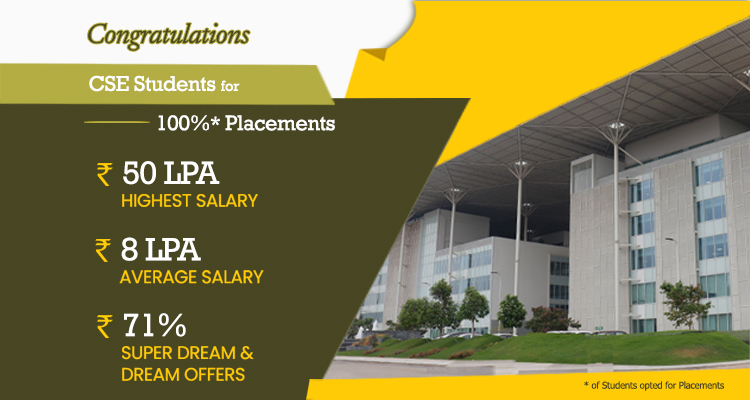 While the maiden batch of the nascent SRM University-AP is ready to set foot for the next venture, the Department of Computer Science and Engineering (CSE) proudly announces 100% successful placement for its students. The first-ever placement drive in SRM University-AP began last year amid the COVID-19 pandemic. However, overcoming all the difficulties, the talented engineers of the CSE department found their passion and a job offer according to their will. The brilliant students of CSE bagged envious offers with the highest salary of 50 LPA and an average salary of 8 LPA. 71% of the students are placed with Super Dream and Dream offers, which is highly commendable.
While the maiden batch of the nascent SRM University-AP is ready to set foot for the next venture, the Department of Computer Science and Engineering (CSE) proudly announces 100% successful placement for its students. The first-ever placement drive in SRM University-AP began last year amid the COVID-19 pandemic. However, overcoming all the difficulties, the talented engineers of the CSE department found their passion and a job offer according to their will. The brilliant students of CSE bagged envious offers with the highest salary of 50 LPA and an average salary of 8 LPA. 71% of the students are placed with Super Dream and Dream offers, which is highly commendable.
Amid the unprecedented crisis, the hiring process was a difficult task to be performed for both the students and the recruiters. Corporate Relations and Career Services (CR&CS), the placement team of the university, has done an excellent job by conducting the placement drive with passion and dedication. The students were provided with every support they needed during these trying times. During their internships and projects in reputed companies, the students had hands-on experience, industry exposure, and became aware of the expectations of the corporate world. This experience helped the students to prepare for the job interviews. The numerous training sessions arranged by the CR&CS team for core and soft skill development brushed up their knowledge and personality. The mock interviews, sessions with corporate experts also assisted the students in their preparation. The interdisciplinary modernised curriculum provided the students with in-depth knowledge in their domain, strengthening their basic skills.
“Every moment at SRM-AP was so defining. Academics and research, 24×7 student-run Next Tech Lab, Semester Abroad and Entrepreneurship at UC Berkeley, USA and winning Hackathon in Bay area competing with MIT, Stanford and Carnegie Mellon gave us the wide exposure of the real world, which would not have been possible without the continuous support of our faculty and university management. Now, it is time that we start our life in Japan, and we are very much looking forward to the new chapter,” said Rajarshi Mazumder, who has received the highest offer of this season with a pay package of 50 LPA along with his twin Saptarshi. Sri Ritika Katragadda, who has been offered one of the best packages with 29.5 LPA, opined, “The selection process was tough, but with the extensive knowledge we gained in the classroom studies, I cleared it with ease.”
“The support I received from my professors and CR&CS team is unforgettable. I am forever grateful to their guidance, for being able to secure such a good offer,” said Sai Krishna Rohith, who bagged an offer of 20 LPA. “Prof Ragunathan is like a father figure to me. I can reach him anytime without any hesitation, even in case of a smallest doubt. All other faculty members were equally supportive,” asserted Venkata Sai Nikhith Nagamlla. Venkata also received an offer of 29.5 LPA.
Mr Vivekanandan, Assistant Director, Corporate Relations and Career Services, said, “We always looked for the best opportunities for our students. The talent exhibited by the CSE students during the internships, projects, curriculum and extra-curriculum activities naturally drew the best recruiters to SRM University-AP.”
“SRM University-AP has made its name as a reputed tech hub to the recruiters who are searching for the best engineers to recruit. We are certain that in the coming years, the numbers of top offers will further increase, creating a record in the country,” shared Professor Ragunathan, Associate Dean in the School of Engineering and Basic Sciences and Head of the Department of Computer Science and Engineering.
“SRM University-AP is founded with the vision to offer quality engineers, entrepreneurs and professionals to the country. In the First Placement Drive itself, the university has proved its mettle and has become a favourable destination for top recruiters,” said Prof V S Rao, Vice-Chancellor, SRM University-AP.
- Published in CR&CS NEWS, CSE NEWS, News, Students Achievements






